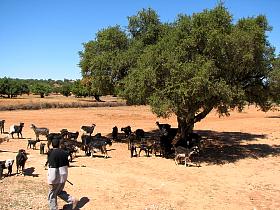Argan, Argania spinosa 
tree of the family Sapotaceae
 Etymology: "spinosa" because of prickly stems Etymology: "spinosa" because of prickly stems
Origin: southwestern Morocco. It dates back to very ancient times (tertiary).
Habitat: The argan tree is very resistant to heat and aridity. It can withstand temperatures up to 50 ° C. With its powerful root system, the argan tree maintains soil, maintains soil fertility and protects against wind and water erosion desertification which threatens much of Morocco.
Hardiness: zone 10 (It does not support frost).
Lifespan: 200 years.
Rate of Growth: slow.
Height: 10 m tall.
Shape: spread.
Wiry, ramified, tortuous and rather short trunk.
Deciduous foliage. Leaves alternate, in the form of spatula or lanceolate, long from 2 to 3 cm, dark green and coriaceous (to resist evaporation).
White flowers with greenish yellow, appearing in May-June.
Fruit: oval berry, fusiform of 30 mm long, yellow-brown in maturity. It is formed of a fleshy pericarp or pulp which covers the very hard stone (or nut). The Argan nut contains one to three "Amandons" (small almonds) albuginea and oily containing up to 55 % of oil.
Use: Oil is extracted from the nuts of argan. One tree produces about 8 kg per year. The Amazigh people (Berber) in Atlas has always used argan oil for food and cosmetic virtues.
The leaves serve as fodder for camels and goats do not hesitate to climb on branches to catch them.
Its wood is used as fuel and carpentry.
The argan tree provides a very hard wood, known as iron wood, used mainly as firewood.
|